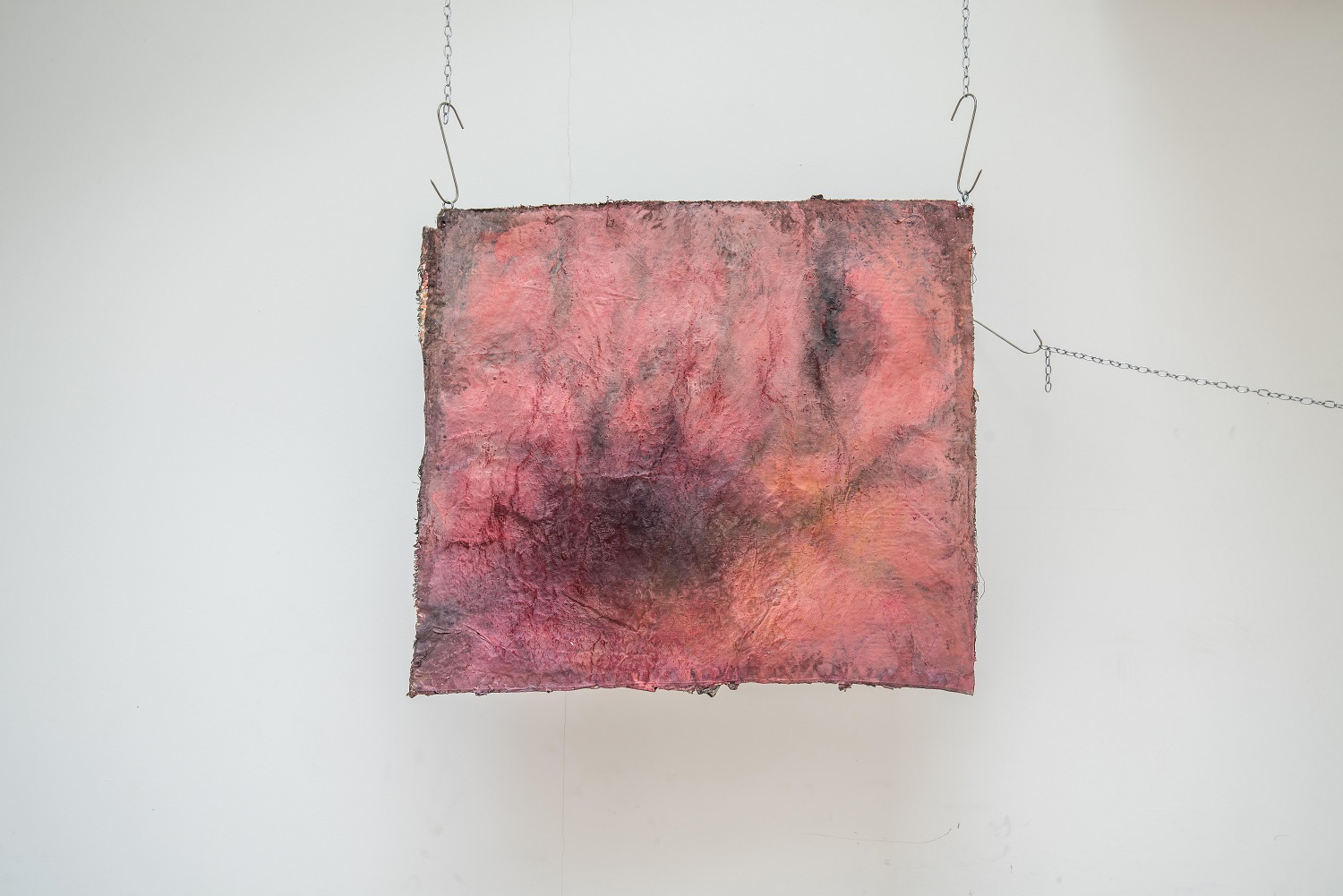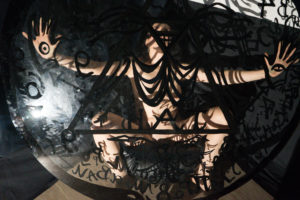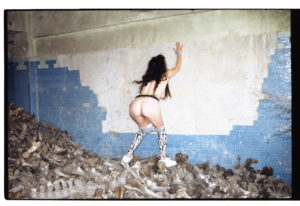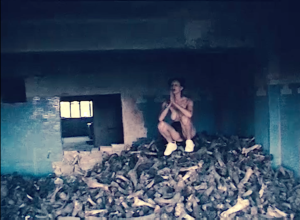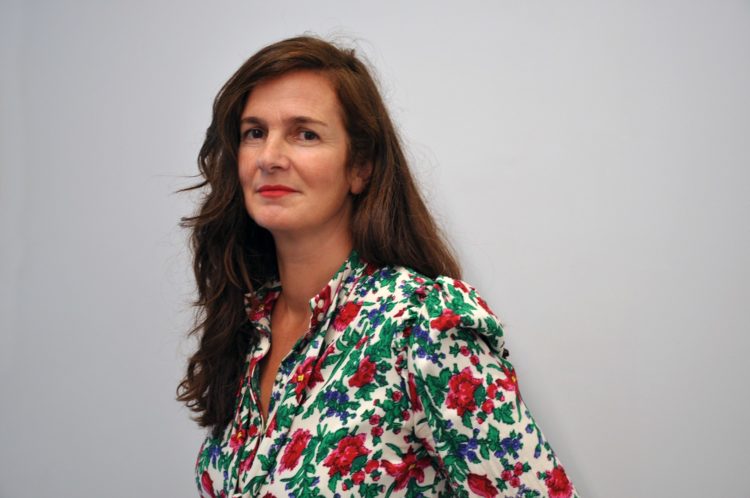Research
Alyona Tokovenko, Untitled, from the series No Time to Heal, acrylic on fabric, hair, 50 × 45 cm, © photo: Matteo Favero
Writing about wounds in her 1995 book States of Injury, political philosopher Wendy Brown claimed that progressive groups have often congregated around “wounded identities” as those in need of recognition and protection from various forms of physical and symbolic violence.1 According to Brown, such politics not only reified stated identities, but also ontologized pain, resulting in profound investments in victimization and suffering. Brown maintained that second-wave feminism in particular had constructed “woman” as an identity founded on damage. Since then, intersectional feminist movements have fought for the recognition of the agency of female subjects – the agency to fight back, to fuck, to feel life in all its complexity of forms and affects. From pornography wars to sexual autonomy, these battles have often been fought with an element of internal disagreement and collateral damage, problematizing the status of victimhood, consent and shame, but leaving many questions unanswered. The wounded kittens might have left the chat, paving the way for new forms of online empowerment, from femcels to esoteric healers, but the scars have not exactly disappeared.
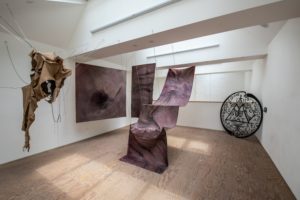
I am not here to be stronger than you, Mimosa House, London, May 3 – June 1, 2023; installation shot: From left to right: Alyona Tokovenko, Untitled, 2022, from the series No Time to Heal, acrylic on fabric, hair, 50 × 45 cm ; Dissected Suit, 2023, from the series Forced Shape, leather, metal chains, meat hooks; Three paintings from the series The Way to Convert, 2023, 160 × 160 cm, 220 × 85 cm, 400 × 120 cm, acrylic on canvas, hair on canvas; and AntiGonna, Fortune Telling By Clitoris, 2023, object/performance prop, drawing on plexiglass, © photo: Matteo Favero
Throughout my curatorial practice I have somewhat subconsciously lingered around artists who could be described as having a post-wounded attitude, as novelist Leslie Jamison might have called it in her book The Empathy Exams.2 Perhaps I didn’t want my personal pain to define me; perhaps I aspired to be like those who didn’t build their identities on the idea of victimhood. Perhaps I was tired of the nauseating mechanism, described by Kathryn Angel as the double bind, that constantly pulls women in different directions: “Of having to balance desire with risk; of having to pay attention so much in the pursuit of pleasure.”3 Women, Angel reminds us, “know that their sexual desire can remove protection from them and can be invoked as proof that violence wasn’t, in fact, violence”.4 Perhaps I was simply bullying myself into numb depression, though to be fair, my pursuit was hardly dictated by the negation of pain. After all, pain is an immanent condition of suffering – it cannot be erased from the body – a sensitive body, one that is exposed to harmful external forces as well as the actions and omissions of other humans. Rather, I was interested in the following question: What kind of alternative affects, beyond those associated with suffering, are available to subjects who are in pain? How does the media and liberal culture police the representation of victimhood? Could we imagine a more nuanced game addressing pain and shame?
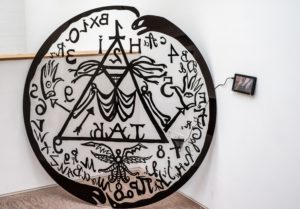
AntiGonna, Fortune Telling By Clitoris, 2023, object/performance prop, drawing on plexiglass; Performance documentation, 2019, © photo: Matteo Favero
These questions returned to me when I first encountered the collaboration of Ukrainian artists Alyona Tokovenko and AntiGonna in the exhibition I am not here to be stronger than you at Mimosa House, London. Curated by Daša Anosova and Alexandra Tryanova, also from Ukraine, the exhibition explored the issues of intimacy and trauma complicating various economies of looking and self-exploration. The presentation included various mediums and interventions by artists whose complementary approaches to representing pain and resistance oblige the visitors to become aware of the different politics of spectatorship. Their practices explore issues of violence, powerlessness, hierarchy and dependence by subverting our fantasies and expectations of what it means to be an ally and the object of compassion, reminding us that violence and care are always in a double bind.
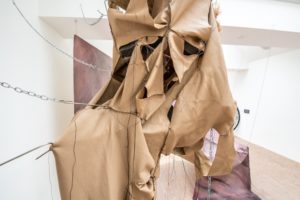
Alyona Tokovenko, Dissected Suit, 2023, from the series Forced Shape, leather, metal chains, meat hooks, © photo: Matteo Favero
The title of the show was inspired by the writings of the Belgian poet of Ukrainian descent Sophie Podolski, an enfant terrible of post-war autofiction who died from suicide at the age of twenty-one in 1974. Known for practising “writing as a living thing”, 5 Podolski herself deserves to be highlighted. It is seldom mentioned that Podolski (b. 1953 in Brussels), today widely gloried as a radical Belgian poet and graphic artist, remained stateless along with her siblings, father and grandfather until she turned twenty, a year before her tragic death. Podolski’s paternal grandfather had fled Ukraine in 1917, on the eve of Bolshevik Revolution, because of which the family remained in exile until acquiring Belgian citizenship in the early 1970s. Podolski became celebrated in countercultural milieus for her astonishing uninhibited novel Le Pays où tout est permis / The country where everything is permitted, a radical stream of consciousness challenging conventional notions of autobiography and political statement, marked by the authors’ self-exploration, experiments with drugs and accounts of schizophrenic episodes. “I am a trip without a traveler, wrote Podolski, “I am not a poet but an unfinished poem”,6 teaching us that consciousness is a fluid and open-ended road.
Though Podolski is only directly invoked by the show’s poignant and captivating title – “I am not here to be stronger than you” – her spirit accompanies Tokovenko and AntiGonna. Both push social taboos and use autobiographical elements to communicate social and more universal truths beyond moralistic concepts of shame and victimhood. The exhibition protagonists, as well as the curators Anosova and Tryanova, belong to the generation of Ukrainian art workers who emerged on the cultural scene in post-Maidan Ukraine, the period marked by artistic milieu’s fundamental involvement in renegotiating the country’s public spheres and social contracts.
Since the ongoing all-out war against Ukraine imposed exile on both the artists and curators, it might be tempting for the Western art world to brand and consume their practices through this tokenising lens. As artist Zhenya Oliinyk articulated recently in one of her drawings, “I feel like whenever someone thinks about me as an artist, they think about me as talking about the war”. Oliinyk’s self-reflexive comment trolls the vulturistic and exploitative op-eds from the “super cool magazine” asking her to “share something about the artist’s pain”.7 Likewise, Tokovenko and AntiGonna confront the same mediatised economy, one that consumes the trauma and suffering of Ukrainians, searching for the perfect victim narrative, for stories of redemption and gratitude. Instead, the artists offer us two counter-representational strategies – a beguiling interplay between figuration and abstraction (Tokovenko), overidentification (AntiGonna), and fragmentary rewiring of memory and trauma (both). Though the war is not explicitly articulated in their works, both artists challenge the violence associated with patriarchy and personal systems of oppression as well as Russia’s imperial and colonial ideologies as they are being experienced via the artists’ corporeal knowledge and on the collective body of the fellow Ukrainians.
“Collective body” is in fact the title of one of the first works by Tokovenko that we encounter in the main space downstairs as we enter the gallery. A long unstretched canvas is suspended from the ceiling, forming a free-flowing canopy structure saturated with pinks, purples and sinewy blues. Naked limbs populate this unusual shroud, one human-like configuration arises from another in a rhizomatic sequence. Although the flesh spreads out in different directions, there’s also a sense of constraint and contortion. This is arguably one of her most figurative recent works in the show, culminating in a sculptural element representing human legs that are attached to the canvas and a mattress – a liminal space between body and ground.
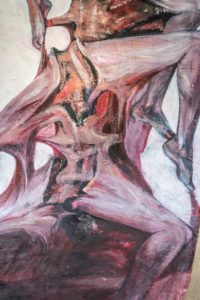
Alyona Tokovenko, fragment from the Collective Body Installation, 2022, acrylic on canvas, 300 × 180 cm, © photo: Matteo Favero
Tokovenko paints with acrylic, allowing herself to quickly react to the speed with which the canvas absorbs the paint. The fluid, bleeding lines, along with the work’s spatial organisation, create an impression of the body as space, a concept important to how Tokovenko approaches her paintings in general, thinking constantly beyond the boundaries of the canvas, but rather prompting different vantage and access points beyond the painting’s flat surface. Are these bodies offered a possibility of change and transformation or are they subject to control and discipline? To whom does the body belong? Despite the fact that the artist made this work in 2022 in exile in Berlin while being subject to various infrastructures of regulation and biopolitics, Collective Body challenges the reductive binaries between passivity and action, submission and agency. Observing it made me think again of the post-wound concept as articulated by Jamison: “A new native language spoken in several dialects: sarcastic, apathetic, opaque; cool and clever.”8 This is a language of apparent contradiction and apparent cruelty, used to consistently organise and realise one’s own experiences and bodily aspects of existence.
The split in self-identification as object and subject is present in her other works downstairs, where figurative elements move seamlessly into more abstract terrains. In the series of paintings entitled I am an insect, Tokovenko reflects on the lost ability to tell living beings from dead ones. The artist recalls seeing an insect in her apartment and being unable to kill it. “The full-scale war deprived me of the ability to squash a living creature”, she admits, “I realized that I feel like an insect myself – someone can crush me down at any moment.”9 Though this may be read as a harrowing confession of vulnerability, Tokovenko transgresses the self-objectification through yet another statement; “mutated into an insect, may become a monster”.10 Consciously alluding to the monstrous subjectivity that these works elicit, the artist delves into abject, libidinal affects that underpin humanity in all its complex forms. There’s no plea for compassion here, the bodies on canvas are presented in their most fleshy, buoyant carnality. Elsewhere, the tension between abstraction and figuration intensifies. While recalling one of her childhood dreams to me over DM (direct message), Tokovenko described a sinister-looking mass of flesh on a shank, stirring itself in circles as if by muscular effort. The movement sped up uncontrollably until it became too intense for the consciousness. When reading this, I imagine how speed and rotation affects the figurative image to move outside of the body and representation into a more abstract register. Tokovenko’s paintings seem to achieve a similar gravity, they are mobile and trembling.
The movement, rapture and the multiple ways in which the female body navigates these notions characterise the work of the exhibition’s co-protagonist, queer artist, performer and filmmaker AntiGonna. As in the practice of Podolski, AntiGonna casts her gaze on society’s fears and taboos around the issues of sexuality and death, and through her own performative autofiction, she renegotiates the questions of trauma, ritual and personal mythology.

AntiGonna, Conjure Grandmother, Conjure Granfather, 2016, © photo: Igor Makedon, Courtesy of the artist
AntiGonna emerged in early 2010s in the underground circles of the Ukrainian art community as a radical performer and pioneer of post-pornographic art. Pushing her own boundaries, the artist creates uncompromising performances in which she confronts the audience with actionist-style body art, elements of grotesque and trash aesthetics. Through her exuberant rituals she offers us new perspectives on what it means to be a thinking and feeling sexual subject experiencing a wide array of often self-conflicting affects. Furthermore, she interrogates mediations of sexuality, trauma and shame in contemporary Ukrainian society, inserting into the sphere of vision what is repressed from the public discourse.

AntiGonna, video-room screening Endless Story of Disease, Kyiv Port Horrors, part 1, SBOYKA, 2016-2021, video, 13 videos from a series, total duration 78’47’’, © photo: Matteo Favero
Between 2016 and 2020 AntiGonna, together with cinematographer and collaborator Andrey Boyko, chronicled parties, staged performances and experimental happenings that occurred in Kyiv’s underground, for example at the infamous Otel’ venue near the Podil district. These performative actions often unraveled in the spirit of the theatre of cruelty, law and substance abuse, aiming to access transgressive states of consciousness and horizontal forms of participation. AntiGonna’s involvement in these experiments – as protagonist, observer and choreographer – mitigates the thin line between the private and public. On one hand, through her rituals, she processes and exorcises personal traumas pertaining to rape and emotional abuse, on the other, she invites others to play out their own autofictions and variations on a given topic.
In their article “Sex in Public”, theorists Lauren Berlant and Michael Werner argued that excluding sex from public debate and presenting it as strictly “personal, heteronormative conventions of intimacy block the building of nonnormative or explicit public sexual cultures.”11 In her performances and films, AntiGonna is preoccupied with animating queer counterpublics as a form of resistance, however what is striking about the context of her practice is that it moves beyond the rudimentary tension between private and public in relation to sexuality. Though sex in society is publicly mediated and its coding reflects our values, desires, fears, structures of domination and opportunities for emancipation, the concept of shame, guilt and other undesirable affects is also present in many countries throughout Eastern Europe as a result of the transition into neoliberalism and aspirational normativity. As Czech scholar Kateřina Kolářová observes, in the post-socialist context, the aspirational utopic promise of the “good life” was often expressed in the moral imperative to overcome the failure and shame of the bad past.12 AntiGonna interrogates this double bind in her video works. One of them, Rave on the Bones, becomes a flipside of the aspirational normativity, but more importantly, it serves as a poignant critique of Western exoticisation of Ukrainian nightlife. Shot three years after Russia’s annexation of Crimea, the video tackled the question of the moral right to continue the lifestyle of raving while being at war. On the one hand, the rave movement since the 2010s has become crucial to social organisation in Ukraine. On the other hand, the Western fantasy around Kyiv as the electronic music hub of Europe fell apart with the full-scale invasion when many Western consumers of the club-hopping lifestyle offered little but selective solidarity. In the video, shot in her signature grimy style, we see AntiGonna performing nude on a heap of animal bones in an abandoned meat factory, a staple of urban gentrification which turns post-industrial spaces into new capitals of leisure and sociality. But arguably, some of the nuances behind the social realities are often not easily translatable, due to the epistemological blind spots between East and West in how we imagine resistance, queerness and feminism. For example, a few years after filming the Rave on the Bones, during martial law, AntiGonna was approached by the Ukrainian electronic music label System to screen her controversial videos at a New Year’s Eve party hosted in the Odesa passenger terminal. Notwithstanding the ongoing threat due to the attack on a Ukrainian ship by the Russian military in the months preceding the party, the screening took place. The display of trashy porn and cruel carnival might seem like a controversial event for a public place, but such sensationalist reading obfuscates a true essence of the terrifying reality – a sovereign nation being attacked by an aggressor. Five years later, on the night of 25th September, 2023, Russia launched a military attack on the very same port facilities, resulting in substantial damage to the Odesa marine terminal.13
AntiGonna’s case is exemplary of how many Ukrainian individuals and collectives inscribe themselves into public spaces after Maidan revolution, despite the ongoing war against Ukraine after the annexation of Crimea, provoking a question what does it mean to be a body within the reach of a military aggression. It also demystifies many overused clichés about pacifism and militarization. To explain in my point let me recall another exhibition, albeit from a different political temporality, namely Alchemic Surrender, staged aboard the Ukrainian battleship, Slavutych, in Sevastopol in 1994 by curator Marta Kuzma. Set against the backdrop of the Budapest Memorandum and Nuclear Non-Proliferation Treaty, which Ukraine joined soon after as a non-nuclear weapon state (transferring its nuclear material to Russia), the exhibition in question involved many anarchic forms of participation. For instance, the artists who lived on the ship procured site-specific works, while some involved the ship crew in their actions; for their performance Voices of Love, Arsen Savadov and Heorhii Senchenkodressed up the naval officers in ballet tutus, playing with codes of masculinity and vulnerability.14 Could we speak of a similar tension between the political event and carnivalesque resistance when looking at performances of AntiGonna? As opposed to Western coverage of the war, which is offered up for consumption, AntiGonna’s self-theoretical narration is a manifestation of her own presence in the knowledge production. Furthermore, the social hysteria around the provocative content in her video performances is exemplary of the double standards in our society where some images of violence and sex are being made taboo while others circulate freely and are aestheticised for the sake of attention economy.
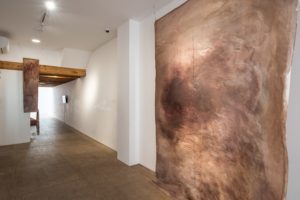
Alyona Tokovenko, Body Flag, 2023, from the series Forced Shape, 250 × 200 cm, acrylic on canvas, © photo: Matteo Favero
Undoubtedly, it’s a different game when academics theorise about social justice and when a person undergoing the most horrific experiences becomes a site of research for themselves. While academic discourses gladly circulate the buzzwords like situated knowledge and embodied practice, AntiGonna and Tokovenko explore the question of what these categories mean when confronted with stereotypes about nonviolence and militancy, about consent and self-exploration. As feminist writers Darya Tsymbalyuk and Iryna Zamuruieva rightly observed, “The many abstract and theoretical discussions about peace, concessions and negotiations are not only a misread of this colonial Russian war, since supporting the abstract notion of ‘peace’ will not stop Russian aggression, but also dismiss the embodied knowledge of Ukrainians who have been persistently asking for help in defending themselves.”15
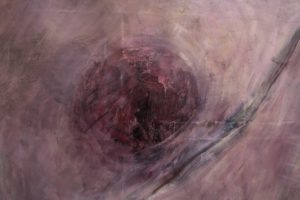
Alyona Tokovenko, Untitled, from the series The Way to Convert, 2023, acrylic on canvas, hair, 160 × 160 cm, © photo: Matteo Favero
It might be a tempting fantasy for allies (including myself) to imagine that their emotional investment in acting on behalf of and in favour of the witnesses and subjects of the War is somehow more authentic and sustainable than the passive consumption of those who just watch. But perhaps what the work of AntiGonna and Alyona Tokovenko shares in this respect is a broader existential truth about the impossibility of compassion and their own witnessing: the emotional loneliness of the one who is bearing witness, and the abyss of destruction that consumes the witness herself. Furthermore, in a more universal sense, their practices flip the fantasy that liberal feminism has about heroic positivity, about capitalism’s insistence on redemption and good vibes. Why are women expected to be constantly defiant, affirmative, and full of gratitude for compassion and for the fact that they are spared abuse and mistreatment? Perhaps the girl who is done with toxic positivity, like “a good victim”, is not there to be stronger than you.
Alison Phipps, “White tears, white rage: Victimhood and (as) violence in mainstream feminism”, European Journal of Cultural Studies 24, no. 1 (2021): pp. 81–93. See also, Wendy Brown, States of Injury: Power and Freedom in Late Modernity (Princeton, NJ: Princeton University Press, 1995), p. 55.
2
Leslie Jamison, “Grand Unified Theory of Female Pain”, in The Empathy Exams: Essays (Minneapolis, MN: Graywolf Press, 2014), p. 396 [ebook].
3
Kathryn Angel, Tomorrow Sex Will be Good Again: Women and Desire in the Age of Consent (London: Verso, 2021), p. 17 [ebook].
4
Ibid.
5
Sophie Podolski, Le Pays où tout est permis = The Country Where Everything Is Permitted, ed. Caroline Dumalin (Brussels: Wiels, 2019), pp. 67.
6
Ibidem, pp. 164–165
7
Zhenya Oliinyk, “From Ukraine with very complex feelings”, 8 March 2023, https://soniakh.com/index.php/2023/03/08/oliinyk-from-ukraine-with-very-complex-feeling/
8
Jamison, “Grand Unified Theory of Female Pain”, p. 321.
9
Quoted in Elena Kozar, “Bloody Trace in Alyona Tokovenko’s Works”, Bird in Flight, 5 August, 2022: https://birdinflight.com/en/inspiration/krivavij-slid-u-robotah-aloni-tokovenko.html.
10
Alyona Tokovenko, Instagram post, @ale_neale, 12 October 2022. https://www.instagram.com/p/CjnWtkGNHX8.
11
Lauren Berlant and Michael Werner, “Sex in Public”, Critical Inquiry, 24, no. 2 (Winter 1998): p. 553.
12
Kateřina Kolářová, “The Inarticulate Post-Socialist Crip on the Cruel Optimism of Neoliberal Transformations”, in Culture – Theory – Disability: Encounters between Disability Studies and Cultural Studies, eds Anne Waldschmidt, Hanjo Berressem and Moritz Ingwersen (New York: Columbia University Press, 2017), p. 241.
13
Tuqa Khalid, “Ukraine says Russian strike on Odesa ‘in retaliation’ for Black Sea HQ attack”, Al Arabiya News, September 25, 2023, https://english.alarabiya.net/News/world/2023/09/25/Ukraine-says-Russian-strike-on-Odesa-in-retaliation-for-Black-Sea-HQ-attack.
14
For more information on this seminal exhibition, please see Alisa Lozhkina, Permanent Revolution: Art in Ukraine, the 20th to the Early 21st Century (Kyiv: ArtHuss, 2019) and Tatiana Kochubinska, “Navigating Intertia, and Sailors in Skirts – Revisiting ‘Alchemic Surrender’ (1994) on a Ukrainian Battleship”, Cultbytes, 13 January 2021: https://cultbytes.com/navigating-intertia-and-sailors-in-skirts-revisiting-alchemic-surrender-1994-on-a-ukrainian-battleship.
15
“We talked to fellow feminists from Ukraine about military aid, here’s what they told us”, BLOK, 1 April 2022: http://blokmagazine.com/we-talked-to-fellow-feminists-from-ukraine-about-military-aid-heres-what-they-told-us/.
Natalia Sielewicz is an art historian and curator at the Museum of Modern Art in Warsaw. In her exhibitions and essays, she addresses the issues of feminism, affect culture, biopolitics, and technology. The curator of the exhibitions: Fedir Tetyanych. The Neverending Eye (2022), The Dark Arts. Aleksandra Waliszewska and Symbolism of the East and North (2022, co-curated together with Alison Gingeras), Agnieszka Polska. The One-Thousand Year Plan (2021), Paint also known as Blood. Women, Affect, and Desire in Contemporary Painting (2019), Hoolifemmes (2017), an exhibition problematizing performativity and dance as tools of female resistance, the exhibition Ministry of Internal Affairs. Intimacy as Text (2017) on affect and the poetics of confession in literature and visual arts. Sielewicz also curated Private Settings (2014), one of the first institutional exhibitions examining the impact of Internet 2.0 on the human condition in the age of late capitalism, and the exhibition Bread and Roses. Artists and the Class Divide (2015, with Łukasz Ronduda).
Natalia Sielewicz, "Feminist Cruelties. Agency and Politics of the Pain in the Work of Alyona Tokovenko and AntiGonna." In Archives of Women Artists, Research and Exhibitions magazine, . URL : https://awarewomenartists.com/en/magazine/cruautes-feministes-pouvoir-daction-et-politique-de-la-douleur-chez-alyona-tokovenko-et-antigonna/. Accessed 10 January 2026
